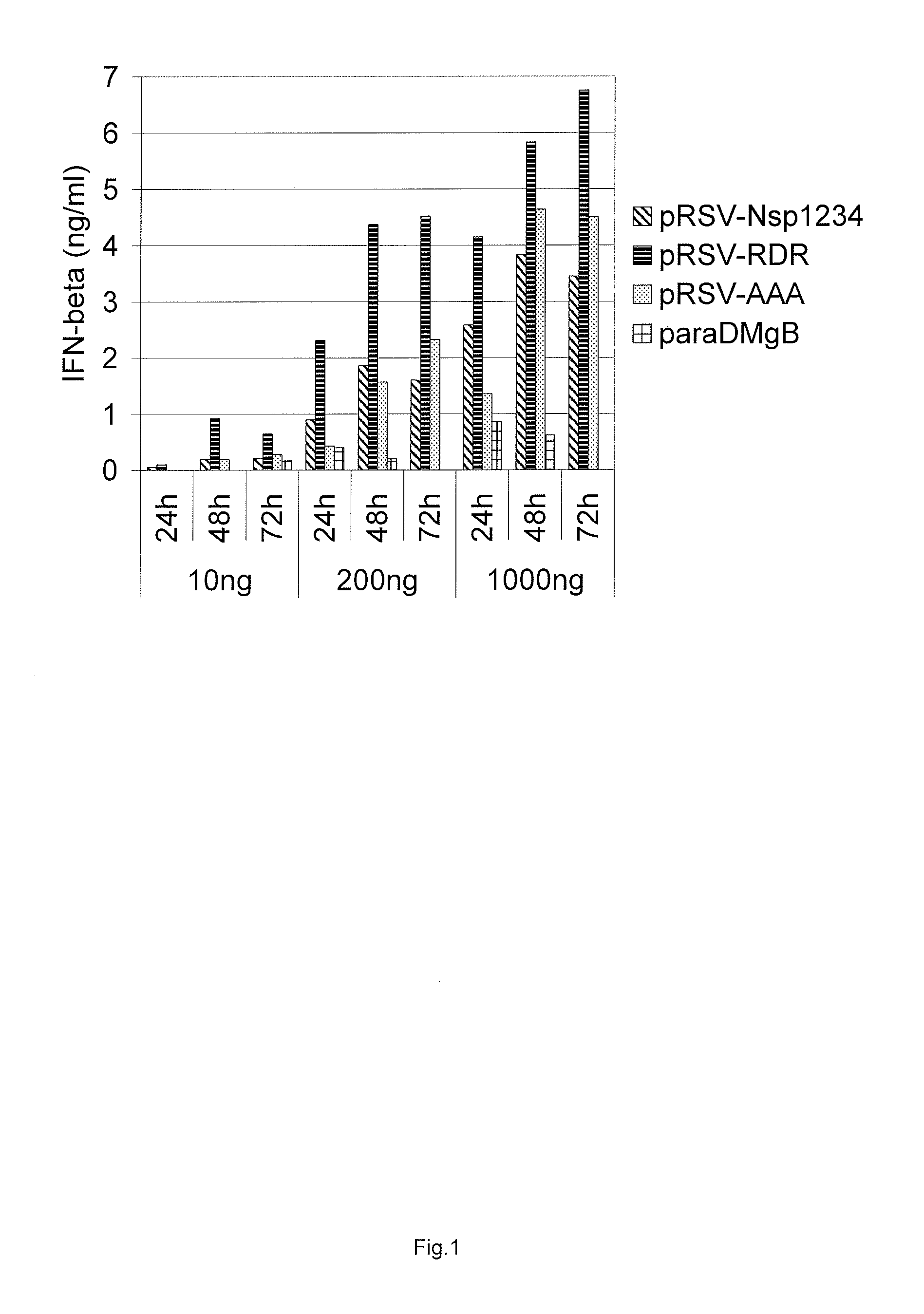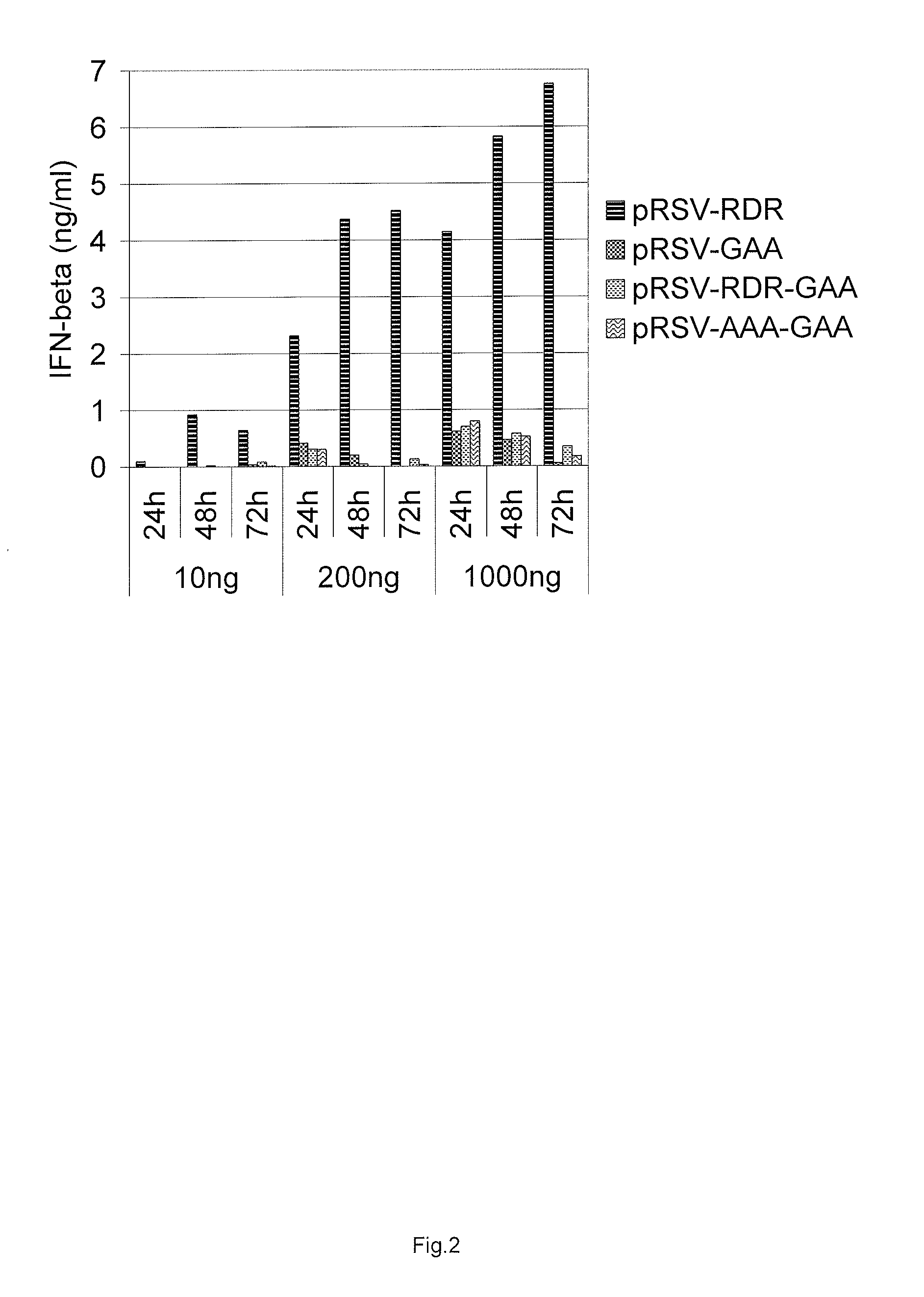Expression vector encoding alphavirus replicase and the use thereof as immunological adjuvant
a technology of expression vector and alphavirus, applied in the field of immunological adjuvants, can solve the problems of continuous and complicated interplay, adverse effects of microorganisms on the host, and significantly complicate the use of such adjuvants, and achieve the effects of boosting and increasing the immune response, and increasing the interferon respons
- Summary
- Abstract
- Description
- Claims
- Application Information
AI Technical Summary
Benefits of technology
Problems solved by technology
Method used
Image
Examples
example 1
Construction of the DNA Plasmids Expressing the SFV Replicase with Mutation RRR>RDR in nsP2 Region
[0133]Previously, the SFV replicase protein sequence (non-structural polypeptide nsP1234) (SEQ ID NO: 1) was back-translated and codon-optimised synthetic cDNA with heterologous rabbit beta-globin gene derived intron (introduced into the coding sequence) was synthesised (SEQ ID NO: 4). The cDNA was inserted into the expression plasmids so that different heterologous Pol II promoter and UTR elements were used for expression of SFV replicase from the codon-optimised coding sequence (FIG. 5). Particularly, Rous sarcoma virus 5′LTR, human elF4A1 promoter and chimeric promoter consisting of human EF1a promoter plus HTLV UTR were utilised. The vectors expressing SFV replicase (SEQ ID NO:1) were named pRSV-Nsp1234 (SEQ ID NO 5), phelF4A1-Nsp1234 (SEQ ID NO 6), and phEF1aHTLV-Nsp1234 (SEQ ID NO 7). In addition, mutations in amino acids 1185-1187 RRR>AAA, in the nsP2 NLS region, were introduced ...
example 2
Induction of Type I Interferon Response by RdRp Expression
[0136]We used Cop5 mouse fibroblast cell line (ATCC number CRL-1804) as a model cell line to discriminate between different replicase constructs for their ability to induce type I interferon expression. Cop-5 cells were propagated in Iscove's Modified Dulbecco's Medium (IMDM) supplemented with 10% fetal calf serum, 2 mM L-Glutamine, and streptomycin-penicillin. Two other human cell lines were also used comparatively—HEK293 and HACAT. Cells were propagated at 37° C. under 5% CO2 and grown to 50 to 70% confluency.
Transfections
[0137]Electroporation was carried out with a Bio-Rad Gene Pulser. Three plasmid DNA concentrations were used for transfections with 10 ng, 200 ng and 1000 ng and equimolar amounts of control plasmids. All five different constructs were assayed for their ability to induce interferon response: pRSV-Nsp1234, pRSV-RDR, pRSV-AAA, pRSV-RDR-GAA, and pRSV-AAA-GAA. Cells were treated with trypsine, harvested by cen...
example 3
Accumulation of dsRNA in Cytoplasm of Replicase Expressing Cells
[0142]It is known that dsRNA intermediates are produced during the replication cycle of the SFV genome or the replicase template RNA. The presence of the dsRNA in the cytoplasmatic compartment signalling the viral infection to the cell and may lead of the antiviral response cascade, including the type I interferon response.
[0143]As is documented above (Example 2), the SFV replicase expression alone induce the type I interferon response in transfected cells. In addition, it was determined that RdRp activity of the replicase is critical for the IFN response, because no IFN response was observed after transfection with the expression vectors bearing GDD>GAA mutation that abolish the RdRp activity (Example 2).
[0144]Thus, the presence and localization of dsRNA in cells transfected with the replicase expression vectors alone was studied. For this purpose IF analysis using anti-dsRNA monoclonal antibody J2 (Scicons, Hungary) w...
PUM
| Property | Measurement | Unit |
|---|---|---|
| time-delay | aaaaa | aaaaa |
| resistance | aaaaa | aaaaa |
| molecular structure | aaaaa | aaaaa |
Abstract
Description
Claims
Application Information
 Login to View More
Login to View More - R&D
- Intellectual Property
- Life Sciences
- Materials
- Tech Scout
- Unparalleled Data Quality
- Higher Quality Content
- 60% Fewer Hallucinations
Browse by: Latest US Patents, China's latest patents, Technical Efficacy Thesaurus, Application Domain, Technology Topic, Popular Technical Reports.
© 2025 PatSnap. All rights reserved.Legal|Privacy policy|Modern Slavery Act Transparency Statement|Sitemap|About US| Contact US: help@patsnap.com



